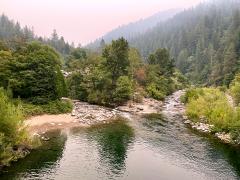Fire-resilient forests have a ripple effect — from trees to landscapes to communities — as their benefits spread beyond their borders to all of us.
The 275,000-acre North Yuba Landscape within California’s Tahoe National Forest is one of the largest contiguous unburned areas remaining in the Sierra Nevada Mountains. It was selected for the Wildfire Crisis Strategy in 2022 as a high-risk landscape.
The North Yuba is also home or backyard for several mountain communities, including Downieville — about 3 square miles with a population of around 250. Like many other small towns within forested lands in the West, Downieville is exposed to significant wildfire risks due to rising temperatures, enduring drought and an overabundance of living and dead trees on the land.
“There’s a lot of potential for large scale, high severity fire if something starts during the summer,” said Andrew Mishler, Acting Yuba River District Ranger. “And the work planned for this landscape really focuses on reducing the density of vegetation around communities and giving that buffer firefighters need to defend them.”
At first it is hard to see the need to remove anything. The sea of green seems like a positive thing, a sign the forest is productive and beautiful. But look closer and consider drought years when these trees and shrubs are water stressed and drying. Then the vegetation becomes potential fuel for a fire.

Smoke from the distant 2021 Dixie Fire encases views along Highway 49 which leads to Downieville within the North Yuba Landscape. Although flames were far away, if ignited, this heavily forested landscape is at high risk of creating a similarly smokey sky if the dense vegetation is not reduced. (USDA Forest Service photo by Jamie Hinrichs).
Wildfire risks become more visible during a drive to Downieville along a winding highway, hemmed in by heavily forested canyons.
This highway is the only way in and out of Downieville for residents and the nearly million visitors each year coming to the Tahoe National Forest for recreation. If the hillsides ignited, entrapment becomes a real danger for everyone. Increasing the wildfire resilience of important forest infrastructure, like roads and bridges, by reducing vegetation around them protects locals and anyone traveling to relax on public lands.
Fire-resilient forests also benefit the water supply, locally and regionally.
“The water resources in this landscape are very important to a lot of communities, not just here in the area, but downstream as well,” said Mishler. “If we lose a lot of this forest cover to fire, we’re going to have sediment and debris flowing into those waterways and impacting water quality.”
The North Yuba Landscape is named for the North Yuba River, which provides drinking water, habitat for sensitive wildlife and recreation along the river.

Map of the North Yuba Landscape (USDA Forest Service map).
But even if you never visit the North Yuba Landscape or even know its name, protecting this water source from wildfire risks affects us all. The North Yuba River supplies 260,000 acre-feet of water for 60,000 acres of productive farmland as far away as the Sacramento Delta. The Delta provides water to nearly 30 million residents in California and supports agriculture supplying food across the country. So if you live in Maine, but you eat asparagus grown in the Delta, you might be absorbing the wildfire resilience of the North Yuba Landscape despite being thousands of miles away.
That’s why the Forest Service and a collaborative group of eight partners — called the North Yuba Partnership — are working to implement the agency’s Wildfire Crisis Strategy in the North Yuba Landscape. Proposed work includes reducing the number of trees on the landscape with ecological thinning. Strategic tree removal can help reduce wildfire risk to communities, lessen the potential for carbon emissions from a catastrophic fire and promote healthy old-growth forest that will be left. Plus, biomass will either be burned by prescribed fire or used for bioenergy — to reduce vegetation on the ground and help stop fire from climbing and spreading quickly into the forest canopy.
“By working together and forming the North Yuba Forest Partnership, we are all able to move more quickly and effectively toward achieving social and environmental resilience,” said Tahoe National Forest Supervisor Eli Ilano. “With 5 million dead trees across the Tahoe in 2022 alone, the urgency of this work has never been more important.”
Recently, the Tahoe National Forest announced it is providing National Forest Foundation $117 million to implement forest management work in the North Yuba Landscape. This investment is the largest agreement between the two organizations in history and will greatly increase the pace and scale of work being completed on the ground in the landscape.
Similar work will be happening in landscapes within national forests throughout the country with the announcement of 11 new landscapes. For updates on the work to reduce wildfire risk or for more information on the Forest Service’s national strategy, please visit Confronting the Wildfire Crisis | US Forest Service (usda.gov).
https://www.fs.usda.gov/features/ripple-effect-of-fire-resilient-forests